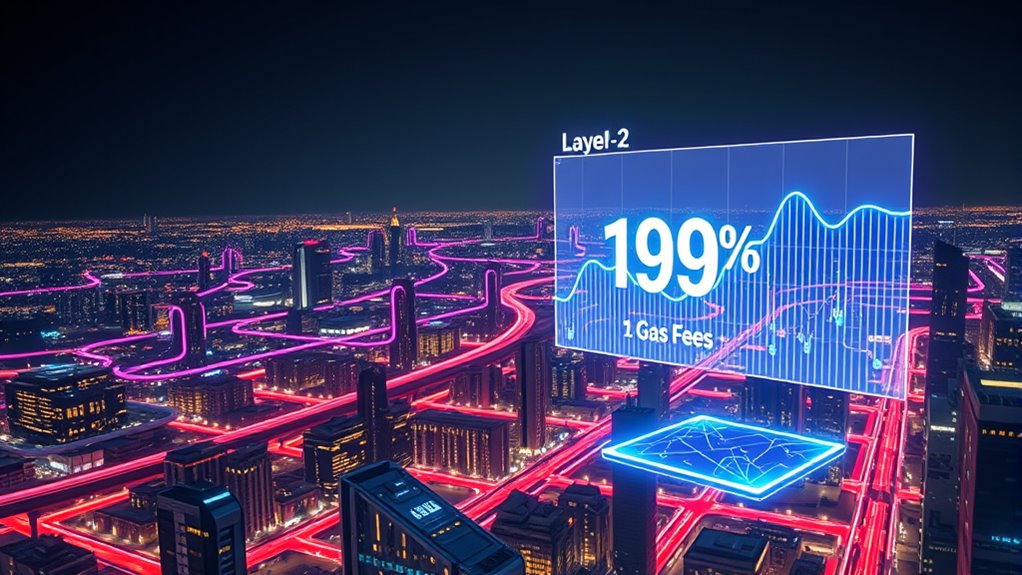To stop overpaying gas fees, you can switch to Layer-2 networks, which move most transactions off the main blockchain to save costs. Techniques like transaction batching, rollups, and state channels lower fees by up to 90% while improving speed and efficiency. These solutions handle high volumes without congestion, making your blockchain activity affordable and fast. If you keep exploring, you’ll discover more ways to maximize savings and optimize your transactions.
Key Takeaways
- Layer-2 networks handle transactions off the main chain, significantly reducing gas fees by up to 90%.
- Techniques like transaction batching and rollups consolidate activities, lowering costs and increasing efficiency.
- Off-chain solutions decrease network congestion, resulting in faster transactions and substantial fee savings.
- Using sidechains and state channels enables frequent activities without high on-chain costs.
- Transitioning to Layer-2 platforms makes decentralized app interactions more affordable and accessible today.

As blockchain activity continues to grow, high gas fees have become a major barrier for users trying to access decentralized applications. These costs can eat into your profits, discourage participation, and make simple transactions feel prohibitively expensive. Fortunately, layer-2 networks offer a practical way to slash your costs dramatically. By moving some of your activity off the main blockchain, you can enjoy faster transactions at a fraction of the price. This approach leverages scalability solutions designed specifically to handle high volumes of transactions efficiently, reducing congestion and lowering fees.
High gas fees hinder blockchain access, but layer-2 solutions make transactions faster and cheaper.
One of the key methods layer-2 solutions use to cut costs is transaction batching. Instead of submitting each transaction individually to the main chain, multiple transactions are bundled together into a single batch. This process minimizes the number of times data needs to be posted on the blockchain, considerably decreasing the gas required per transaction. With transaction batching, you can perform numerous activities—sending tokens, interacting with smart contracts, or executing trades—without the typical high fees associated with each individual operation. This efficiency makes layer-2 networks especially appealing for frequent users who want to keep expenses low while maintaining security.
Scalability solutions like rollups, state channels, and sidechains underpin these improvements. Rollups, for example, aggregate many transactions into a single proof submitted on the main chain, drastically reducing costs. State channels enable you to conduct multiple off-chain transactions with only the final state recorded on-chain, eliminating unnecessary on-chain interactions. Sidechains operate independently from the main chain but are connected securely, enabling you to transfer assets and execute transactions at a lower cost. These scalability solutions are designed to increase throughput, reduce latency, and most importantly, cut your gas fees by handling the bulk of activity off the congested main network.
Additionally, as the demand for blockchain services increases, more sophisticated solutions like the vetted Flat Iron Bike systems are being integrated to optimize performance and reliability across various use cases. You don’t have to accept high gas fees as an unavoidable expense. By choosing layer-2 solutions that incorporate transaction batching and other scalability methods, you can enjoy seamless, low-cost interactions with decentralized applications. These networks are built to handle the increasing demand for blockchain services without breaking the bank. Whether you’re trading, gaming, or managing assets, shifting your activity to layer-2 can save you up to 90% in fees, making blockchain more accessible and affordable. So, instead of overpaying for transactions, explore these layer-2 options today, and start experiencing the benefits of a more scalable, cost-efficient blockchain environment.
Frequently Asked Questions
How Secure Are Layer-2 Solutions Compared to Mainnet Transactions?
You might wonder how secure layer-2 solutions are compared to mainnet transactions. While they generally offer strong security, privacy concerns arise since data is often processed off-chain. This can impact decentralization, but reputable layer-2 networks still maintain robust safeguards. Overall, they’re secure enough for most uses, but understanding the trade-offs helps you decide if they meet your privacy and decentralization needs compared to mainnet transactions.
Can Layer-2 Networks Handle All Types of Blockchain Transactions?
Like a skilled conductor, layer-2 networks orchestrate transactions efficiently, but they can’t handle every note. While they excel in transaction speed and enhancing user experience, certain complex or large-scale transactions still rely on the mainnet’s security. So, you might find that not all blockchain transactions are suitable for layer-2 solutions yet—some require the robustness of the mainnet, especially when security and complexity are key.
What Are the Potential Risks Involved With Layer-2 Networks?
You should be aware that layer-2 networks, while reducing costs, come with risks like centralization concerns, where a few entities might control network operations. Additionally, user privacy can be compromised if data isn’t properly protected or encrypted. These risks mean you need to choose reputable layer-2 solutions carefully, understanding that some trade-offs may affect your control and privacy. Always stay informed about the network’s security measures.
How Easy Is It to Migrate Existing Assets to Layer-2?
Transferring your assets to a layer-2 network is fairly straightforward, especially with user-friendly platforms that simplify asset transfer and platform integration. You typically just need to connect your wallet, select your assets, and follow the step-by-step process. While some platforms may have variations, most aim to make the migration process seamless and quick, reducing your costs and improving transaction efficiency.
Are Layer-2 Solutions Compatible With All Blockchain Platforms?
Imagine a universal translator, bridging languages effortlessly. Layer-2 solutions aren’t compatible with all blockchains, but many are designed for cross-chain compatibility and network interoperability. This means they can work across multiple platforms, like Ethereum or Binance Smart Chain. However, some networks may need custom integrations. You’ll want to verify each Layer-2’s specific compatibility features to guarantee seamless operation and cost-saving benefits.
Conclusion
By exploring layer-2 networks, you’re gently steering away from the high costs of traditional gas fees. Think of it as finding a smoother, more affordable route through the blockchain landscape. With these tools, you get to keep more of your gains while enjoying a seamless experience. So, why not make the switch today? It’s a small change that could lead to a much more budget-friendly and enjoyable crypto journey.









